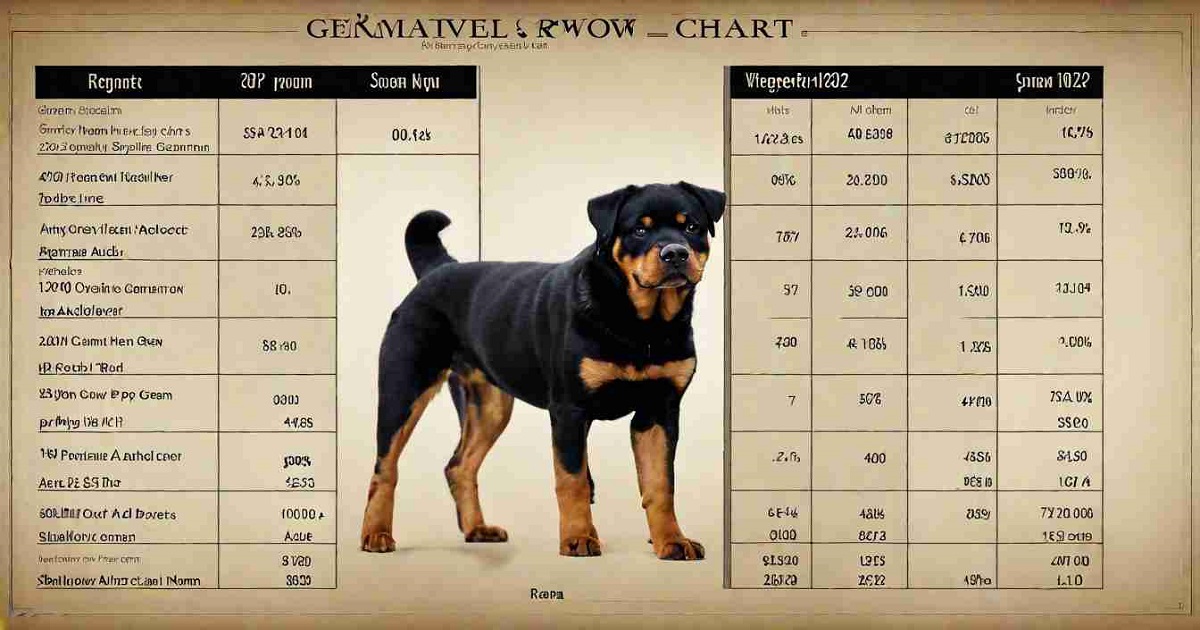You know what? When I made the choice to bring home my Rottweiler puppy I had absolutely no clue, about the challenges that awaited me.
Wrong! There are three types of rotties, and if you don’t do your research, you can end up with a drool-on-wheels who knocks down your child and chases the neighbor’s cat every time it escapes. Whoops!
So after many trials and tribulations (and apologies to my neighbor), I wanted to write this guide to help other potential first-time Rottweiler owners.
Here’s what you need to know about the major differences between three types of rotties American, German, and Roman Rottweilers before picking out your new best fur-friend!
A Quick History of Big Bad Rotties
But first, a quick history lesson so you can see how we ended up with such variation in this iconic breed. The Rottweiler originated (obviously) in Rottweil, Germany, where they were used to herd livestock and pull carts of butchered meat to market. This earned them the nickname “Rottweil butchers’ dogs.”
Rotties were strong and stocky, perfect for protecting the butcher’s money bags on those long trips. As railroads replaced carts, Rottweilers started working with the police, using their intelligence and strength to apprehend criminals and guard facilities.
When Rottweilers came to America in the 1930s, breeders started selecting for a taller, leaner dog better suited for show rings and athletics. And voila, the American and German variations emerged! Roman Rottweilers also appeared later as attempts to recreate the oldest, largest Rottweiler phenotype.
Now, on to the fun part – a deep dive into what makes each type unique!
The All Three Types of Rotties
Let’s start with the red, white and blue boyos. American Rottweilers are known for being the tallest of the bunch, thanks to those longer legs. Their necks are also longer than German or Roman Rotties, giving them a sleek appearance. They tend to be leaner overall with a narrower head and snout.
All this lankiness makes the American Rottweiler lightning-fast and nimble compared to its bulky European counterparts.
American Rotties have the most energy and stamina, which is great if you’re looking for a jogging partner or agility competitor. These pups excel at dog sports thanks to their athleticism and eagerness to work.
In my experience, American Rottweilers do best with active owners who have time to run them ragged every day.
If left alone too much, their boredom translates to destructive chewing, digging and play that’s a bit too rowdy for kids or small pets. Proper training and exercise are a must!
On the plus side, American Rotties have a goofy playfulness that fits right into an energetic family. And their herding heritage means they bond closely with their humans. Just be ready for an 85-pound lapdog!
Rotties with Wursts: The German Variation
If American Rottweilers are the triathletes, German Rotties are the powerlifters. German breeders focused on retaining the old-school Rottweiler form: stockier with a broader head, thicker neck and overall heavier build.
This gives German Rottweilers unparalleled strength and stamina, which makes them excellent police, guard and service dogs.
Don’t be surprised if your German Rottie tries to instinctively “herd” small kids, pets and even you with gentle nips or barks. Early socialization helps mitigate this urge.
The trade-off of all that brawn is less speed and agility compared to the American type. But German Rotties are still nimble for their size. With the right handler, they excel at advanced obedience competitions and weight pulls.
Something to note is that German Rottweilers tend to have a calmer temperament and energy level than Americans.
But they can get destructive without proper training and requires experienced owners. German Rotties also need mental stimulation along with exercise to stay happy.
Overall, this variation is best suited to a moderately active home able to provide consistent leadership and training.
Their relatively calm nature (for a Rottweiler) makes German Rotties good family pets. Just supervise play with little kids.
Ancient Beasts: The Roman Rottweiler
Roman Rottweilers are a sight to behold, looking more like petite mastiffs than regular Rotties. As the name suggests, Roman Rottweilers are an attempt to recreate the legendary “Old Type” Rottweiler that worked with the Roman legions.
This means Roman Rotties have burly frames with incredibly stocky bones and rippling muscles. They have the shortest muzzles and super-blocky heads – giving them almost a Neapolitan Mastiff look. Males get up to 150 pounds or more!
All that mass makes Roman Rottweilers mellow couch potatoes happy to lounge the day away (while taking up your whole sofa). But their guarding instincts are second to none – making Roman Rotties sought-after protection dogs.
However, that protective nature needs proper guidance. Roman Rottweilers can be aloof with strangers and aggressive with other dogs if not socialized extensively as puppies.
These giants are not ideal pets for first-time owners. Experienced handlers are a must for these strong-willed titans. Proper obedience training starts the day you bring home your Roman Rottie pup.
Roman Rottweilers are also quite rare outside of Italy, so expect to pay a princely sum to acquire one of these noble beasts. Just prepare for copious amounts of drool flowing from that heavy jowl!
Battle of the Rotties: Head-to-Head Comparisons
Now that we’ve covered each type’s origins and traits, let’s directly compare some key characteristics. This chart should help summarize the major differences between the types:
| Trait | American | German | Roman |
| Size | Tallest | Medium height | Shortest in height but heaviest in weight |
| Build | Lean, athletic | Stocky and muscular | Heaviest bone structure and musculature |
| Energy Level | Highest energy and stamina | Medium energy | Lowest energy, calm temperament |
| Trainability | Eager to learn, high working drive | Steady worker, strong instincts | Strong-willed but trainable |
| Kid/Pet Friendly | Best of 3 types, needs supervision | Usually good, needs socialization | Can have aggression issues without training |
| Grooming | Moderate shedding | Heavy seasonal shedding | Very heavy shedding |
| Lifespan | 8 to 10 years | 8 to 10 years | 7 to 9 years |
As you can see, American Rottweilers take the gold for energy, trainability and playfulness. But they need plenty of activity and training not to get destructive.
German Rottweilers are great all-around family pets with proper leadership. They have the strength for police work but remain loyal companions. Moderate grooming needs are a plus.
Finally, Roman Rottweilers are stunning guardians but require intensely dedicated owners. Their shorter life expectancy is likely due to health issues from their ultra-large size. Major drool issues too!
How to Pick the Perfect Rottweiler for You
Hopefully this info dump helps highlight the key differences that impact living with each Rottweiler type. Here are some of the major factors to consider when deciding which variation best fits your lifestyle:
- Activity Level: American Rotties need marathon running sessions, agility courses and constant play. German Rotties need moderate exercise like brisk walks and training. Romans are happy with shorter strolls.
- Kids & Pets: American Rottweilers tend to tolerate kids and pets best, but all types need extensive socialization. Supervise interactions until trained.
- Training Needs: All Rottweilers require thorough obedience training. Americans love to learn tricks and compete. Germans have strong instinctual drives to manage. Romans are bossy and need an assertive owner.
- Grooming & Shedding: Americans and Germans shed a moderate amount year-round with seasonal blows. Romans shed heavily all the time – drool galore!
- Your Lifestyle: Hikers, runners and sporty types match best with American Rotties. Families and moderately active owners do well with Germans. Romans need experienced owners 100% committed to training.
Also consider your preferences for look and size. Do you like the sleek American style or bulky German form? Is a couch-potato Roman or energetic American a better fit?
Meeting parents of prospective puppies is invaluable. Temperament and drive can vary in all types, so evaluate each dog as an individual too. If possible, spend time with adult dogs of each type to get a feel for their personalities.
Most of all, make sure you can fully commit to training, exercising and providing for your Rottweiler before jumping in!
Bringing Home Your New Rottie: Prep and Supplies
Got your heart set on a Rottweiler after all that? Here are my top tips for prepping for your new pup and must-have supplies to get:
Puppy-Proof! Rottweiler puppies grow fast into clumsy teenaged elephants. Remove any valuables they can destroy and block access to unsafe areas. Secure trash cans also – trust me on that.
Find a Vet. Interview vets in your area experienced with giant breeds. Schedule an initial puppy check-up for vaccine and deworming needs. Also ask about budgeting for future care.
Collar & Leash: Buy a sturdy collar or harness and strong leash suited for large, powerful pups. A 6 foot leash will give you best control.
Crate: A crate big enough for your Rottie fully grown keeps them and your home safe when you can’t supervise directly.
Food & Bowls: Buy high-quality large breed puppy food and size-appropriate dishes your Rottie can’t tip over. Stainless steel or ceramic work best.
Toys: Stock up on tough chew toys and balls to save your shoes and furniture. Rotate toys to keep your pet engaged.
Grooming Supplies: Slicker brush, nail clippers and shampoo suited for double coats will keep your Rottie looking shiny.
Cleaners: Nature’s Miracle or similar pet stain/odor removers are must-haves for inevitable accidents during training.
Baby Gates: Use gates to block off areas and keep your pup contained and safe when you’re not actively watching them.
Pro tip: Stick to a strict schedule for feeding, potty breaks, training, exercise and playtime. Puppies thrive on consistency and boundaries. Crate training is essential for teaching bladder control.
Raising Your Rottweiler Right: Training Musts
Here comes the serious part: training. Rottweilers are super smart, but all that brainpower goes to waste without proper guidance. Make sure you know what you’re signing up for before getting a Rottie:
Start Young: Enroll your Rottweiler in puppy kindergarten and obedience training as young as 8 weeks old. This socialization is CRUCIAL.
Commit to Classes: Attend advanced obedience courses through adulthood. Rotties need continual stimulation and practice to be happy, controlled companions.
Stay Firm: Rottweilers will walk all over weak owners. Use positive reinforcement but be uncompromising, consistent and assertive. They need strong leadership.
Discourage Herding: Stop any nipping or circling behavior right away to prevent future aggression issues. Redirect with toys instead.
Socialize Always: Introduce your Rottweiler to new people, pets, places, sounds and experiences constantly to build confidence.
Exercise Daily: Walks, runs, swimming and playtime are musts. Mentally tire them out too with training sessions and puzzle toys.
Trust me, putting in the hard work now pays off exponentially with an adult Rottweiler who is a joy to own for years to come. Slack on the training, and you’ll be miserable – and so will your dog.
Watch Out for These Common Health Issues
With their large size comes some health considerations. Here are the major conditions owners should familiarize themselves with:
- Hip & Elbow Dysplasia: Malformed joints that can cause lameness and arthritis, especially in poorly bred dogs.
- Bloat: Deadly twisting of the stomach. Limit meals and water earlier than and after intense exercising.
- Cancer: Rottweilers are prone to osteosarcoma, lymphoma and other cancers. Spay/neuter at appropriate age may reduce risk.
- Heart Conditions: Subaortic stenosis, cardiomegaly and other heart issues can affect Rottweilers.
- Allergies: Food, contact and environmental allergies may cause skin irritation, ear infections, diarrhea/vomiting.
As always, buy from reputable breeders who health test breeding dogs. And be diligent about annual vet checks to catch issues early.
The Joys and Tribulations of Life with a Rottie
After over a year with my American Rottweiler, Crosby, I can honestly say these big babies are worth all the challenges. Sure, I’ve sacrificed some furniture, dealt with muddy paws on my pants every day, and installed a high-voltage collar to keep him from jumping the fence. Oh, and I’ve swallowed enough loose fur to knit a sweater.
But I’ve also gained the sweetest, funniest, most loyal companion I could ask for. The feeling when Crosby greets me with his whole body wagging – Rottie smile on full display – makes all the chewed shoes totally worth it.
I hope this guide gives you a realistic preview of the ups and downs of owning each type of Rottweiler. But don’t let their size and reputation scare you off.
With responsible breeding, proper training and devoted care, Rottweilers pay back your investment exponentially in love and devotion. Just make sure you do your homework before taking the plunge!
Now if you’ll excuse me, I need to take Crosby on his daily 5-mile run before he destroys my new couch. Wish me luck!
Frequently Asked Questions
What is the distinction between male and female Rottweilers?
- Male Rottweilers have a tendency to be large and more territorial. Females are often more independent. Gender differences are less pronounced if dogs are spayed/neutered. Pick the individual dog best suited for you.
How much exercise does a Rottweiler need?
- All types need at least 60-90 minutes of vigorous exercise daily. American Rottweilers need the most exercise while Romans can get by with slightly less. Mental stimulation is important too.
What kind of coat care do Rottweilers need?
- Rottweilers have a double-coat that sheds moderately to heavily year-round. Brush at least weekly to control loose hair. Bathe only when needed to maintain natural oils. Trim nails regularly.
Are Rottweilers good family dogs?
- When properly trained and socialized, Rottweilers can be excellent family companions devoted to children. Always supervise young kids and dogs. American Rottweilers usually do best.
How much space does a Rottweiler need?
- Rottweilers are large, active dogs that need room to move. A house with a securely fenced yard is ideal. Apartments can work with enough daily exercise outside.
What should I feed my Rottweiler puppy?
- Feed a premium large breed puppy food for proper growth. Feed 3-4 small meals a day until 6-12 months old, then switch to adult food 2-3 times a day. Limit treats.
Are Rottweilers easy to train?
- Rottweilers are highly intelligent and aim to please but need consistent, firm leadership. Professional training is highly recommended starting as a puppy. They excel at obedience, agility and other dog sports.
Do Rottweilers drool a lot?
- Some drooling is common with Rottweilers, especially after drinking and eating. Excessive drooling can indicate a health issue. Roman Rottweilers tend to have the most drool.










Guys, we all know that it’s much easier and a lot more enjoyable to have
intercourse when a girl is good and damp. But for some good cause, a lot of
dudes still have a tendency to neglect to get their gal nice and slippery before
they begin going at it. It’s regular to feel a little bit uncomfortable for the 1st several thrusts, but once she’s all
lubricated, it should end up being a even trip. Certain, a lot of men think they
can’t help themselves and simply move for it, but they want to remember that females need more period to get aroused.
So, if you place in the effort to create her damp during foreplay, you’ll be in for a great time.
It fails to consider much, but you may need
to be individual if she takes a while to get in the feeling.